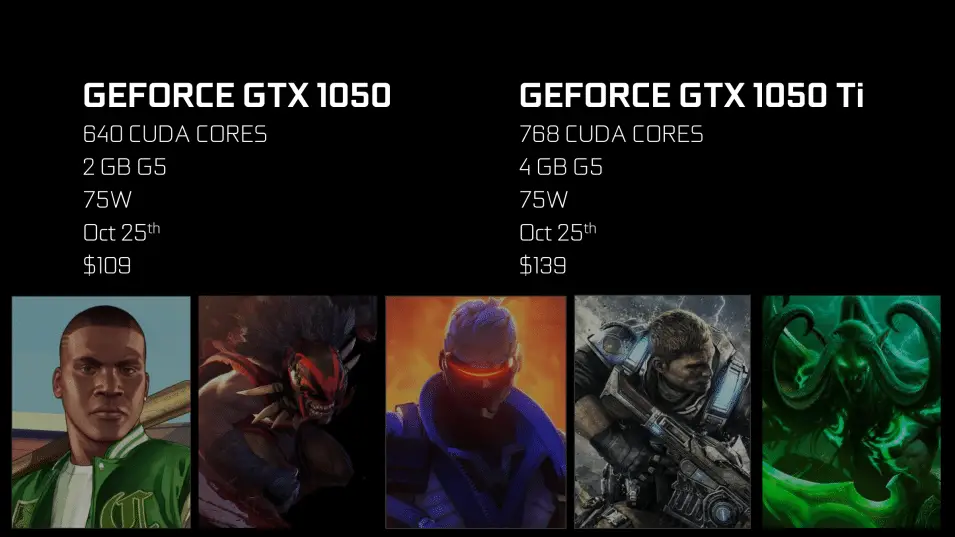After a long period of rumors, Nvidia has officially introduced the Geforce GTX 1050 Ti and GTX 1050, which take the architecture Pascal to the entry-level segment. The goal for the duo is above all to deliver a good experience in 1,920 x 1,080 pixels, but Nvidia also claims that the better of the models should keep the measure of virtual reality.
Earlier in October, Oculus announced that system requirements had been lowered for Rift, something made possible by a technology called Asynchronous Spacewarp. It is a feature that allows games to be rendered at 45 frames per second (fps), which are duplicated and changed to display a frame rate of 90 fps.
The introduction of the technology means that the minimum requirement on the graphics card side went down from a Geforce GTX 970 to a much cheaper GTX 960. The upcoming GTX 1050 Ti will in turn perform better than the latter, which means that Nvidia expects it to reach the Oculus minimum requirement.
Specifications: GTX 1050 Ti and GTX 1050
GTX 1050 Ti | GTX 1050 | GTX 750 Ti | GTX 750 | |
|---|---|---|---|---|
Technical | Samsung 14 nm | Samsung 14 nm | TSMC 28 nm | TSMC 28 nm |
Circuit | GP107 | GP107 | GM107 | GM107 |
Circuit surface | 132 mm2 | 132 mm2 | 148 mm2 | 148 mm2 |
Transistors | 3.3 billion | 3.3 billion | 1.87 billion | 1.87 billion |
Architecture | Pascal | Pascal | Maxwell | Maxwell |
CUDA cores | 768 st. | 640 st. | 640 st. | 512 st. |
Texture units | 48 st. | 40 st. | 40 st. | 32 st. |
Raster units | 32 st. | 32 st. | 16 st. | 16 st. |
Clock frequency | 1 290 MHz | 1 354 MHz | 1 020 MHz | 1 020 MHz |
GPU Boost | 1 382 MHz | 1 455 MHz | 1 085 MHz | 1 085 MHz |
Computational power | 2 123 GFLOPS | 1 862 GFLOPS | 1 389 GFLOPS | 1 111 GFLOPS |
Memory bus | 128-bit | 128-bit | 128-bit | 128-bit |
Memory amount | 4 GB GDDR5 | 2 GB GDDR5 | 4/2 GB GDDR5 | 2 GB GDDR5 |
Memory frequency | 7 000 MHz | 7 000 MHz | 5 400 MHz | 5 000 MHz |
Memory bandwidth | 112 GB/s | 112 GB/s | 86,4 GB/s | 80 GB/s |
Power supply | – | – | – | – |
TDP | 75 W | 75 W | 60 W | 55 W |
However, Nvidia’s new Geforce GTX 1050 Ti is not a direct replacement for the GTX 960, but instead the GTX 750 Ti. The heart of the graphics card is the GP107 circuit, which Nvidia now confirms is manufactured on Samsung’s 14-nanometer technology. The same goes for the GTX 1050 which comes with a slightly scaled-down variant.
In addition to a graphics circuit with fewer CUDA cores and texture units, a distinctive difference with the GTX 1050 is that it only has 2 GB of GDDR5, instead of the 4 GB of GDDR5 that sits in the GTX 1050 Ti. Both models have a TDP value of 75 W, which means that they can be operated without additional power supply from a PCI Express connector.
On October 25, the media will publish tests on both graphics cards, of which the GTX 1050 Ti will start sales on the same day. The Geforce GTX 1050 is expected to appear a little later, but no later than November 8.















